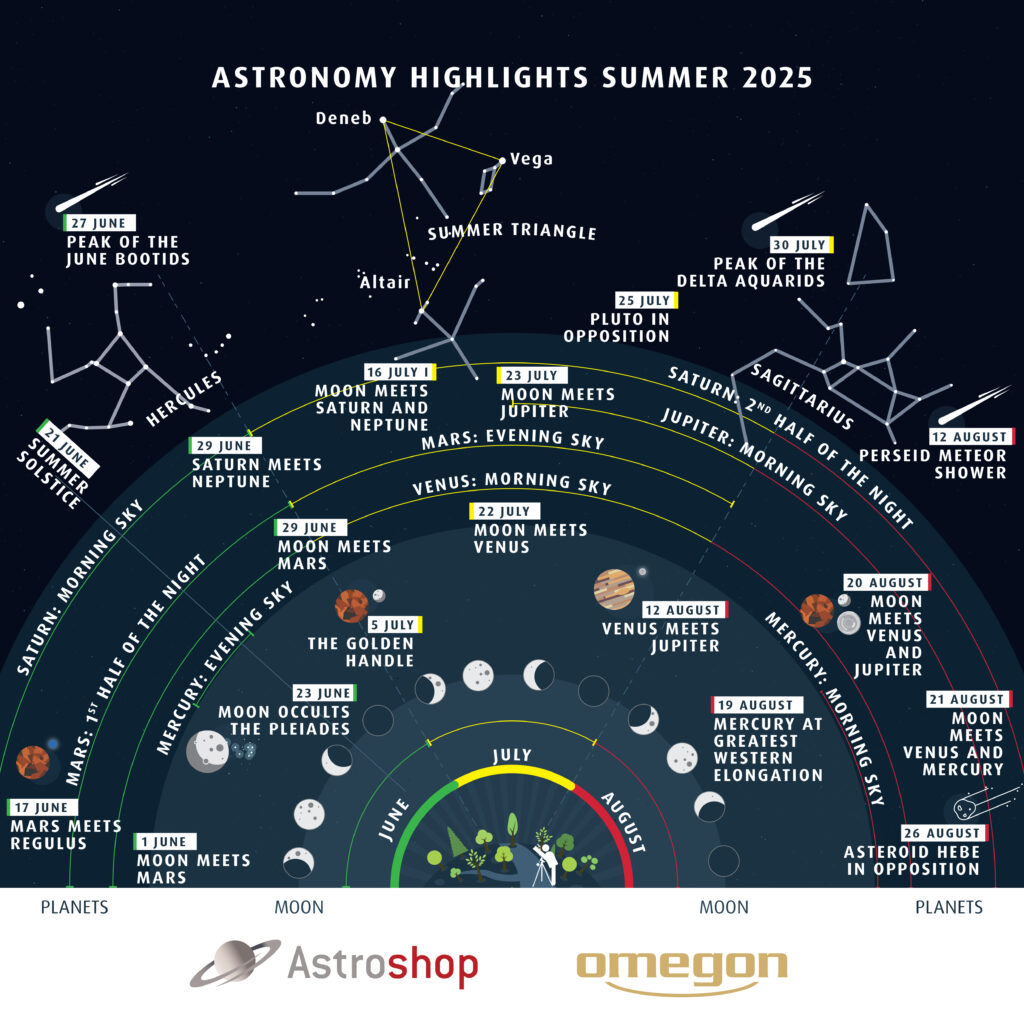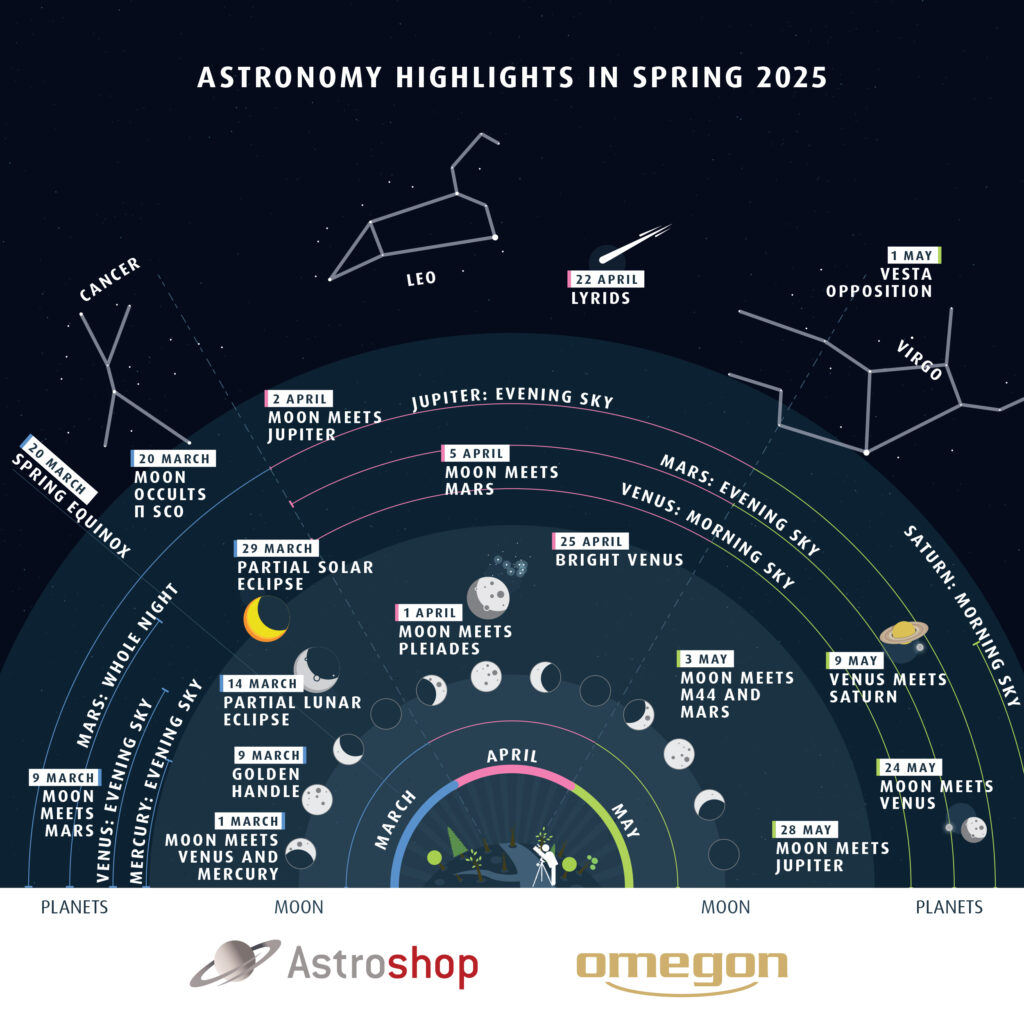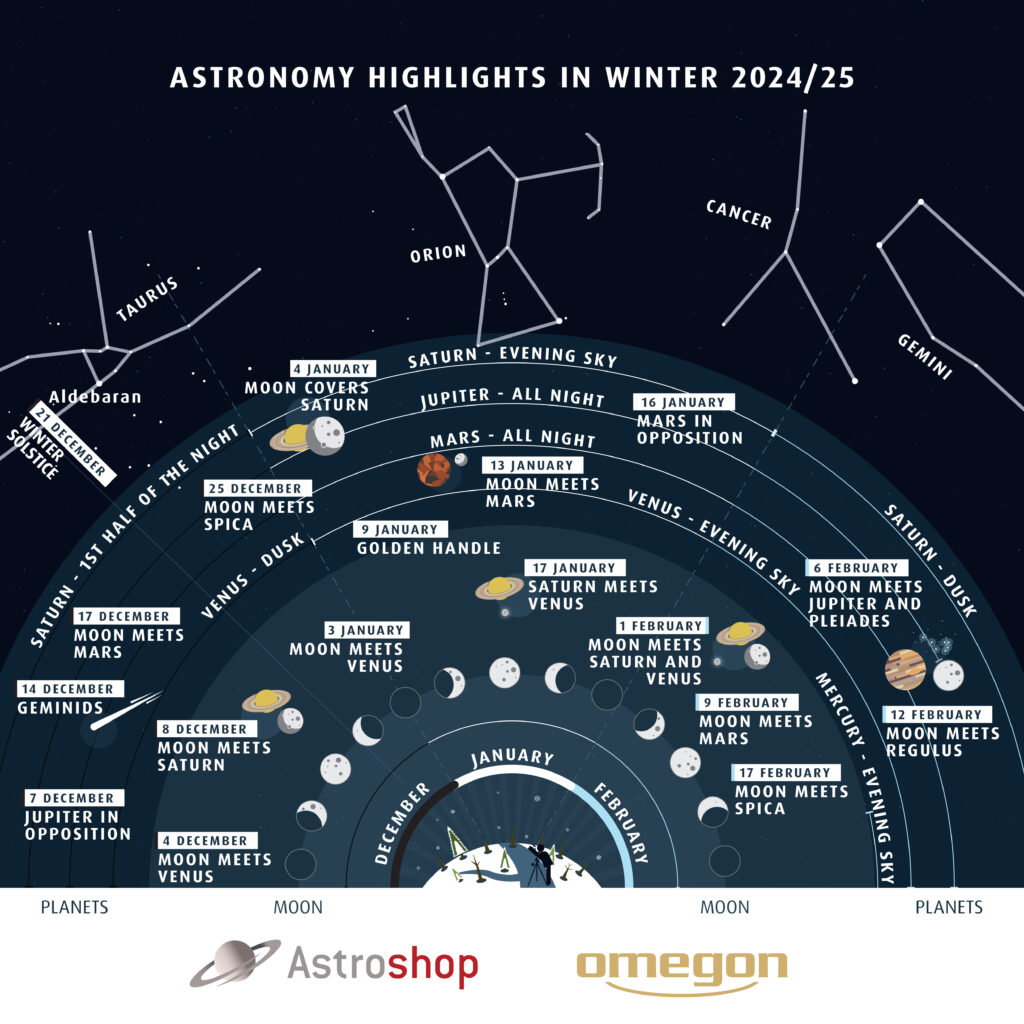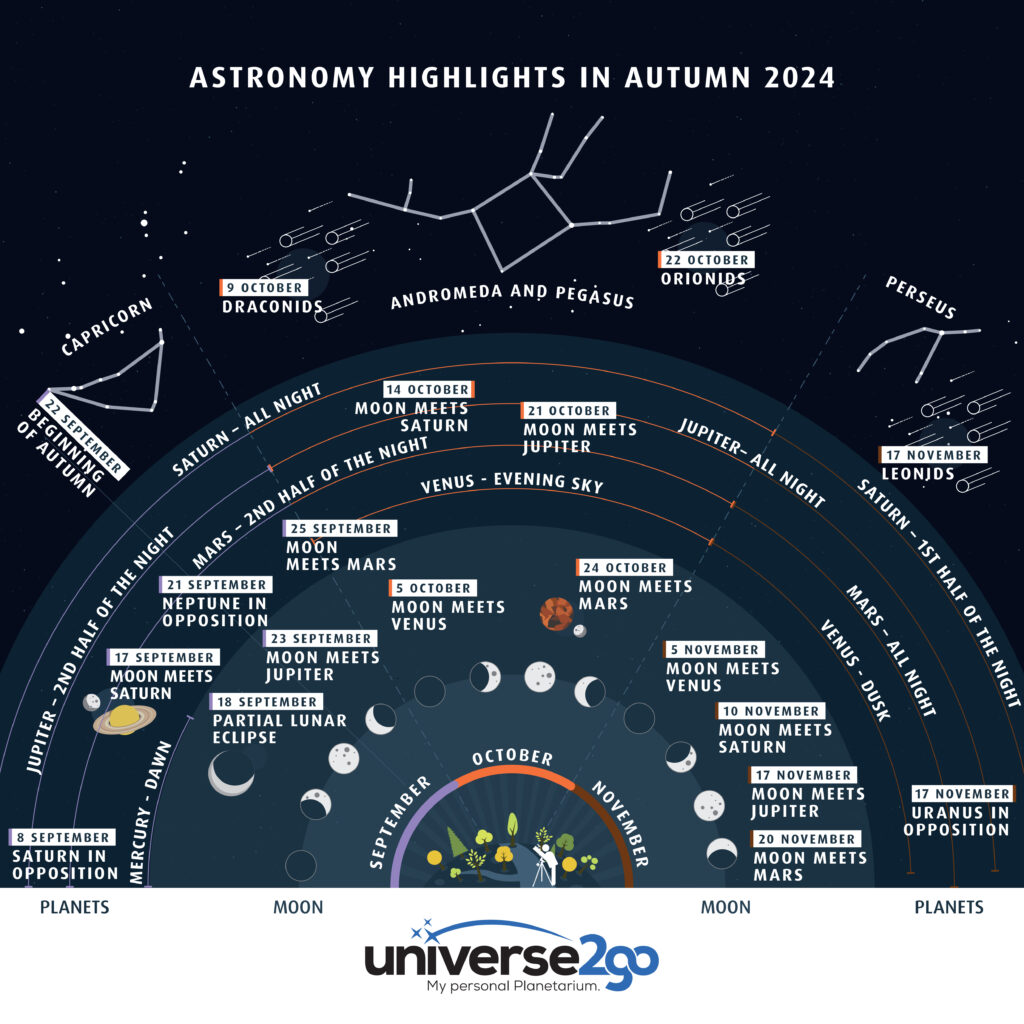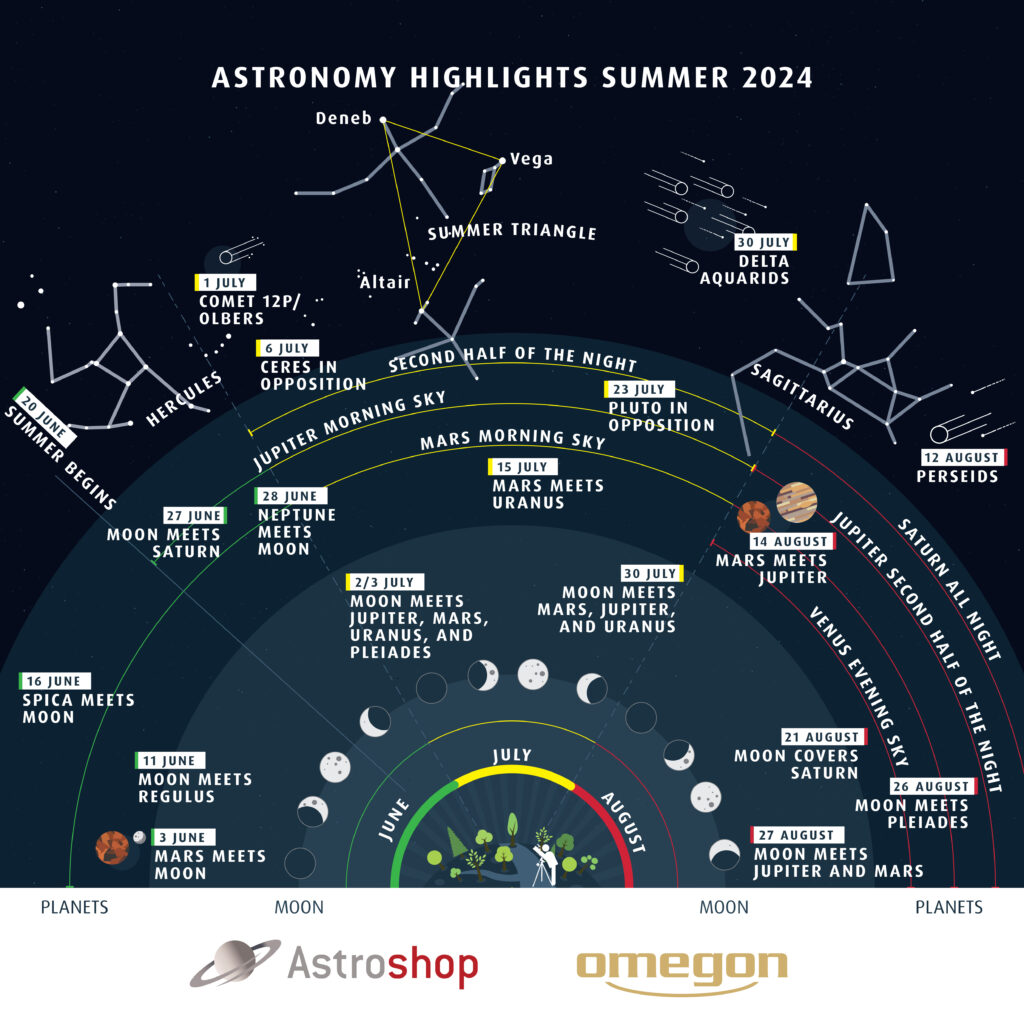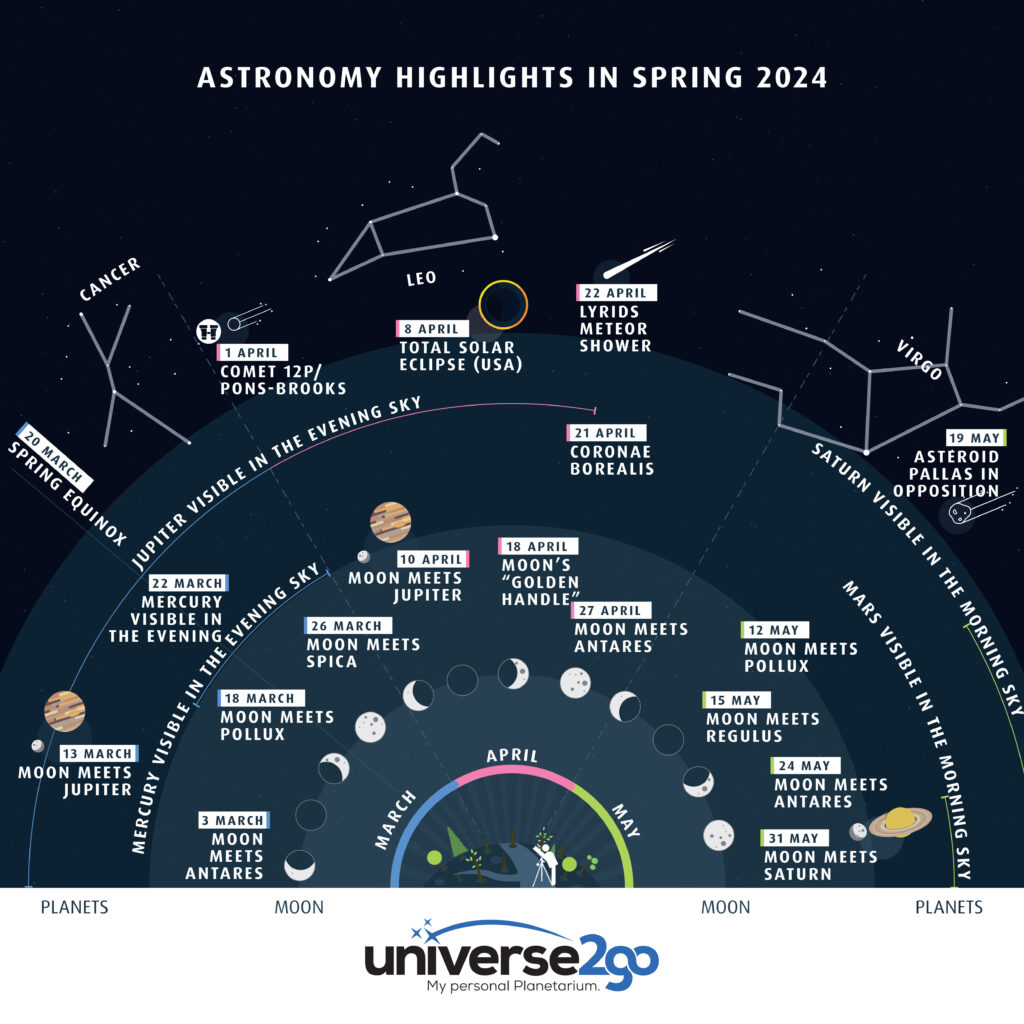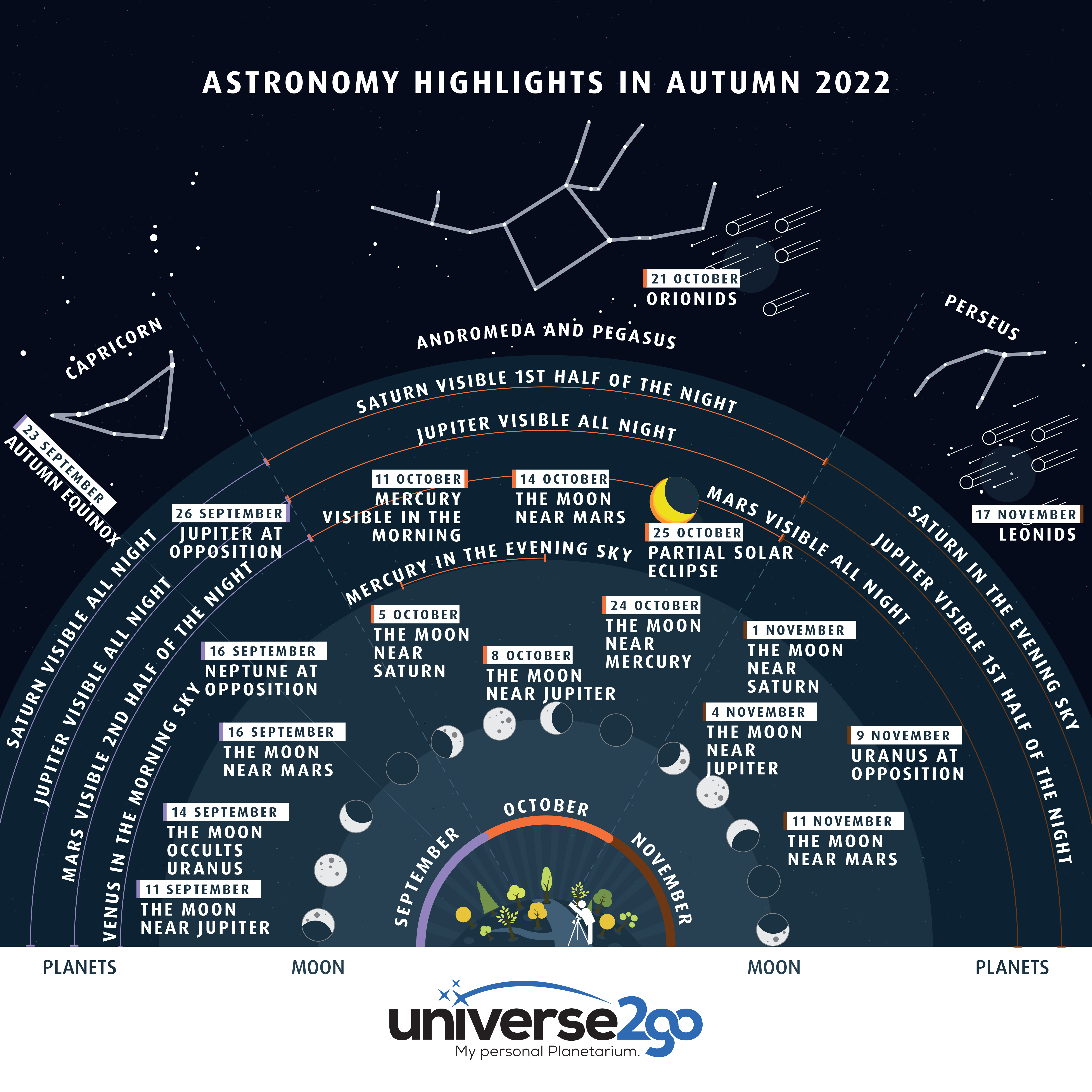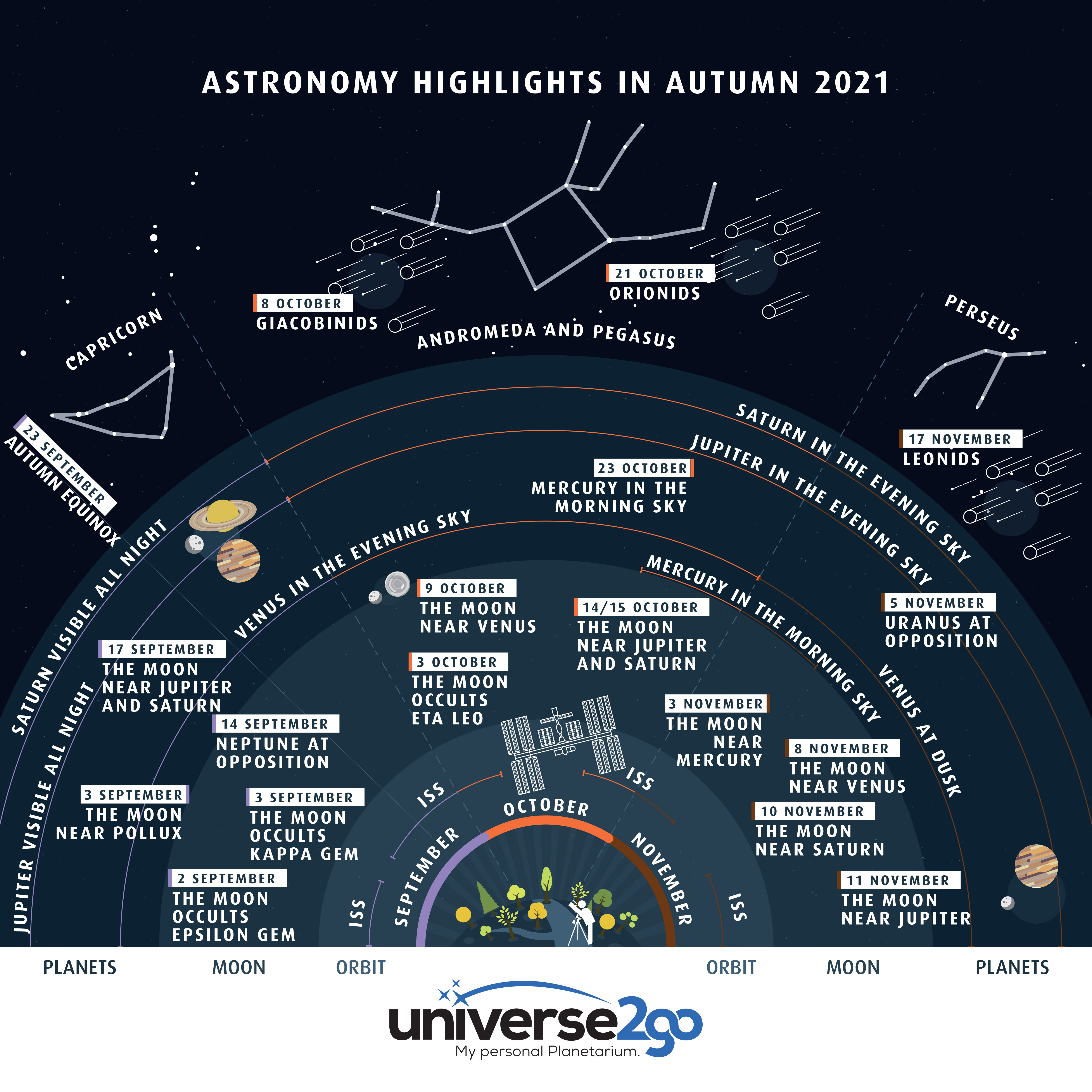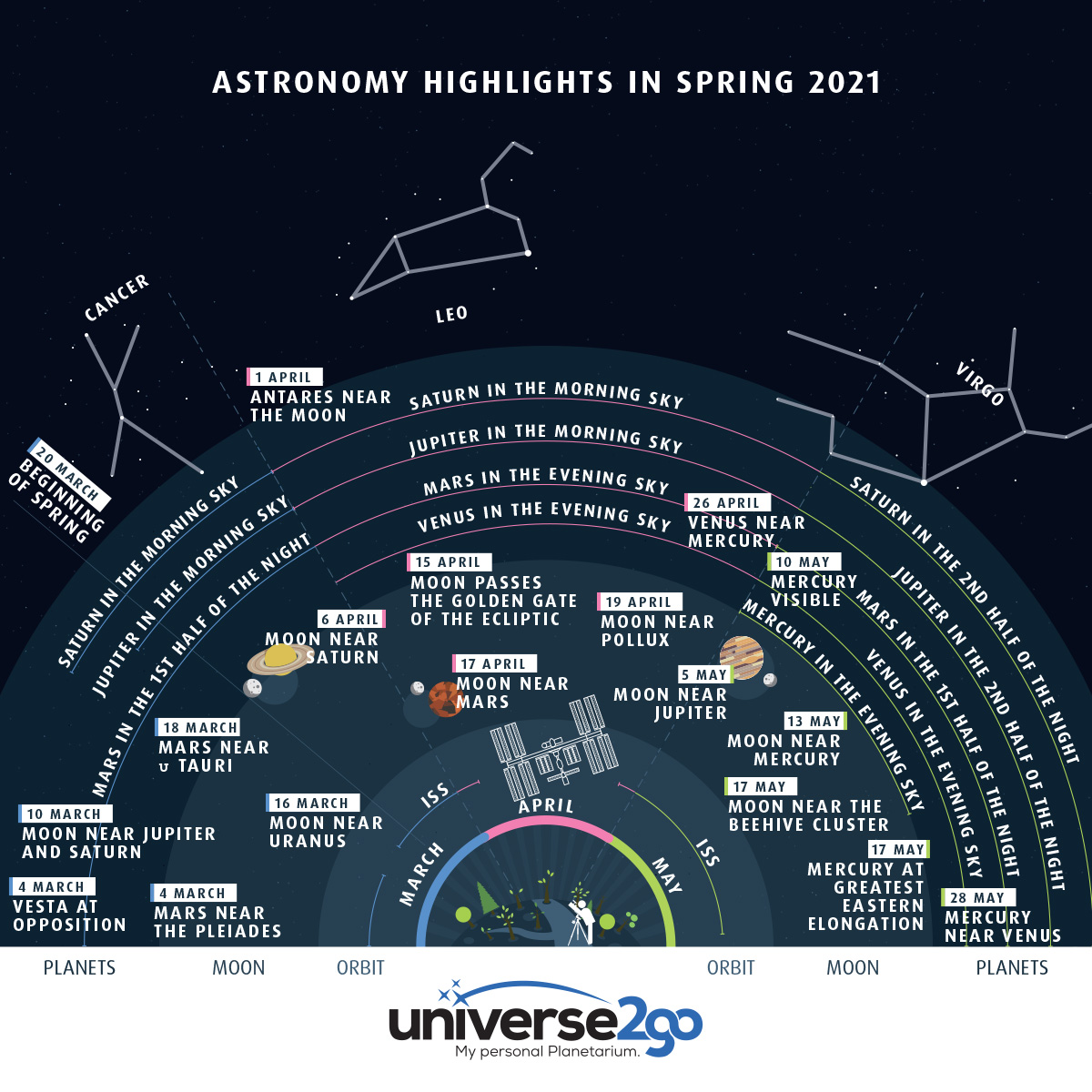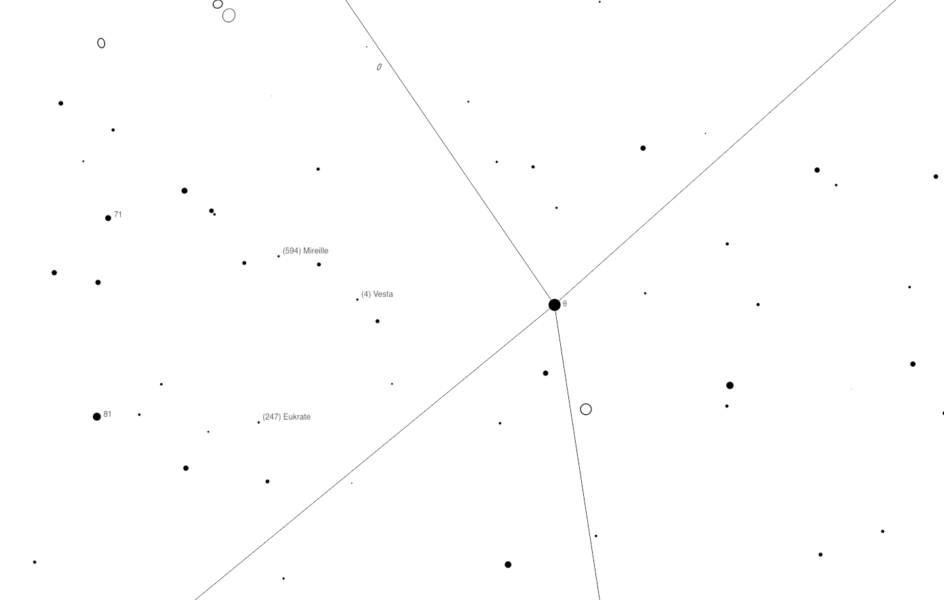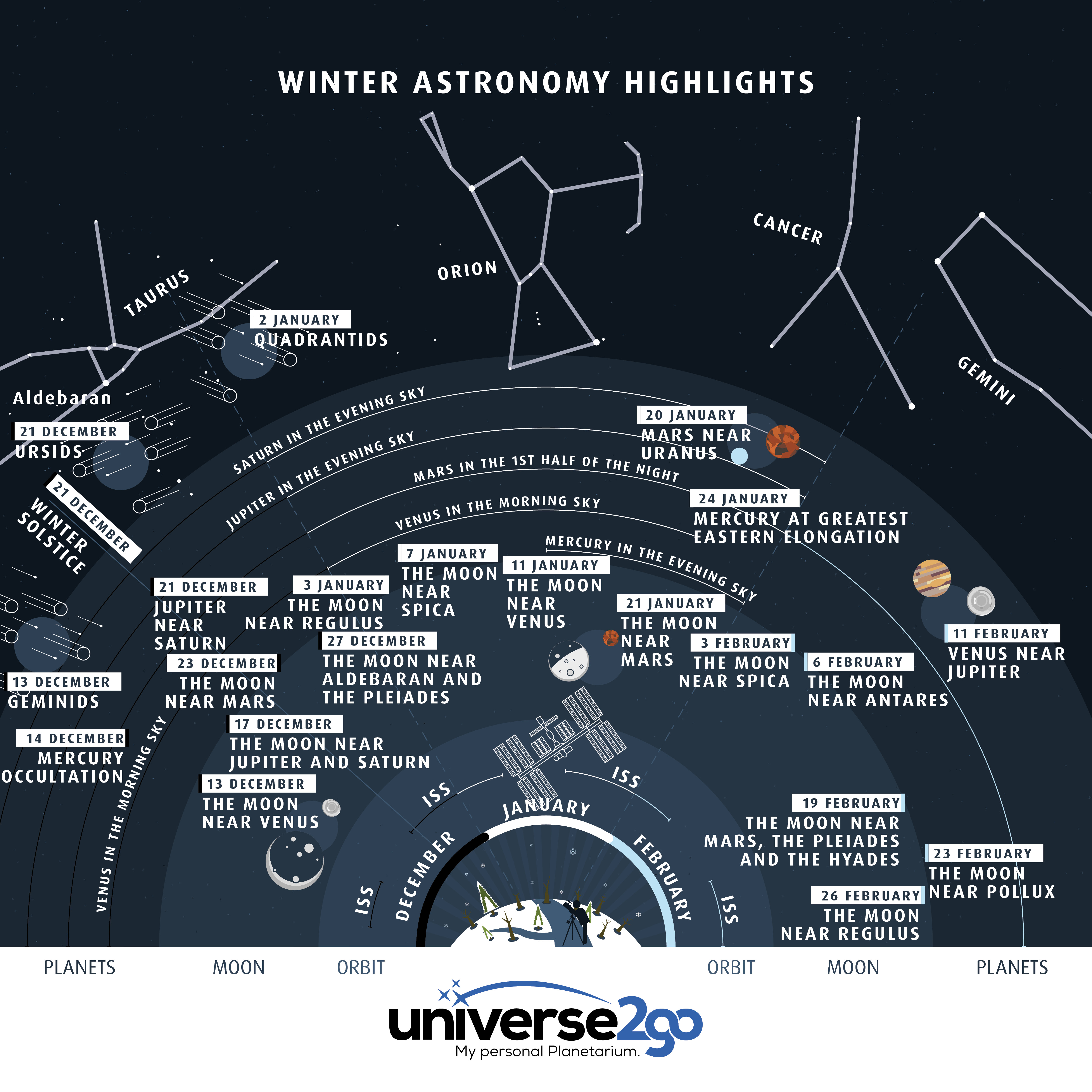The summer of 2025 offers plenty of exciting highlights for skywatchers that shouldn’t be missed. Why? Simple: meteor showers, Mercury visible in the morning and evening skies, or even an occultation of the Pleiades. Whether with the naked eye, binoculars, or a telescope—there’s lots to discover once again. Here are the most beautiful astronomical events in June, July, and August.
June
June 1: Moon meets Mars
On the evening of June 1, the Moon positions itself between Mars and Regulus. The Moon is in its waxing phase, about six days old, and appears as a half-moon. The red planet Mars shines with a brightness of 1.2 mag, appearing as a distinctive reddish point in the sky. The two celestial bodies are about 4 degrees apart—a lovely constellation easily visible to the naked eye. Perfect for anyone wanting to say “hello” to the red planet again.
June 17: Mars meets Regulus
Mars and Regulus move closer together in the evening sky. The red Mars and the bluish main star of Leo form a striking color duo. Regulus, also known as Alpha Leonis, means “little king”—a fitting name for this bright star located right on the ecliptic. Because of this, it is frequently occulted by the Moon or planets.
June 23: Moon occults the Pleiades
A rare event: Early this morning, the Moon occults two stars of the Pleiades—Merope and Alcyone. Around 3:55 a.m. (CEST), Merope disappears behind the Moon, followed by Alcyone at 4:27 a.m. A clear view toward the northeastern horizon is essential. The Moon and Pleiades rise above the horizon starting at 3:30 a.m. After the occultation, the stars reappear on the far side of the Moon: Merope at 4:37 a.m., Alcyone at 4:59 a.m. By the end, it will already be quite bright outside—but still a great show for early birds.
June 27: Peak of the June Bootids
Today the June Bootid meteor shower reaches its peak. The number of meteors is variable and usually low—but still worth a look, especially since there have been years with surprisingly many shooting stars.
June 29: Saturn and Neptune close together
In the second half of the night, Saturn and Neptune come within just one degree of each other. This close encounter is ideal for a wide-angle eyepiece on a telescope or binoculars. A great opportunity to see both planets together in the same field of view.
June 29: Moon meets Mars
In the evening, a slender waxing crescent Moon stands just below Mars in the constellation Leo. Around 10 p.m., the Moon is about 17 degrees above the horizon. By then, it’s dark enough for good observation of the two celestial bodies.
July
July 5: The Golden Handle
Visible tonight: the “Golden Handle” on the Moon. This light phenomenon occurs when the rising Sun illuminates the mountain peaks of the Jura Mountains along the edge of Mare Imbrium, while the surrounding valley remains in darkness. The Moon is about 83 percent illuminated. A sight not to be missed.
July 16: Moon meets Saturn and Neptune
In the second half of the night, the Moon approaches the planets Saturn and Neptune to within about 3.5 degrees. A rewarding trio for large binoculars.
July 22: Moon meets Venus
Between yesterday and today, the Moon passed by bright Venus. Both are in the constellation Taurus. The fine crescent and the bright planet just above the horizon make for a great opportunity for a quick morning observation or a beautiful atmospheric photo.
July 23: Moon meets Jupiter
Just one day later (compared to the event on July 22), the Moon meets the giant planet Jupiter, currently in the constellation Gemini. The Moon is already 27.7 days old and thus very thin. To the delight of all deep-sky observers, it will become a new moon tomorrow.
July 25: Pluto in opposition
Pluto is in opposition today. The dwarf planet reaches a brightness of 14.4 mag—too faint for the naked eye, but photographically accessible with larger or smart telescopes. For visual observation, a finding chart is essential.
July 30: Peak of the Delta Aquariids
Watch for the Delta Aquariid meteors on July 30. These meteors appear in the region of the constellation Aquarius and reach a peak rate of 25 per hour. This year, the Moon won’t interfere much, as it sets early before the night really gets going. It’s a great time to pick a nice observation spot and prepare a hot tea.
August
August 12: Venus and Jupiter very close
In the morning sky, Venus and Jupiter are extremely close together today—less than 1 degree apart. That’s really rare! Venus shines at -4 mag, Jupiter at -1.9 mag. A fantastic sight that will impress you even with the naked eye.
August 12: Perseid meteor shower
The Perseids, as astronomers call them, streak abundantly across the sky this evening, and we watch the skies in anticipation. Perhaps we’ll spot some bright ones to enjoy especially. The media often promise a bombastic firework of 100 meteors per hour—a shower of shooting stars. That’s usually an exaggeration. But even without “hype,” the Perseids can be a sensual and fascinating experience for us. Unfortunately, the Moon’s bright light interferes this year, masking the fainter meteors. But no worries—there are still plenty of bright meteors waiting to be discovered.
August 19: Mercury at greatest western elongation
Speedy Mercury is at greatest western elongation today. This is now a good opportunity to spot it in the morning sky. The planet shines at -0.2 mag and is visible just above the eastern horizon shortly before sunrise.
August 20: Moon near Venus and Jupiter
An aesthetic trio: The ultra-thin crescent Moon (new moon is in three days) passes by Venus and Jupiter today. A wonderful subject for photographers.
August 21: Moon near Venus and Mercury
One day later, the Moon approaches Venus and Mercury. All three line up like pearls on a string above the eastern horizon. Tip: You’ll need an unobstructed view to the horizon to catch low-lying Mercury.
August 26: Asteroid Hebe in opposition
The asteroid Hebe is in opposition today, meaning it is directly opposite the Sun and optimally visible. Hebe is one of the brighter asteroids—a fascinating target with a telescope and finding chart.

